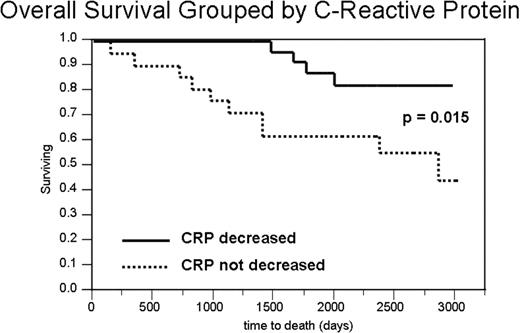Abstract
Abstract 2945
We have previously reported on a Phase II trial using IL-1Ra and dexamethasone, in patients with SMM/IMM, showing that IL-1Ra targets the myeloma proliferative component which parallels a decrease in the C-reactive protein, a surrogate for IL-6 production. (Mayo Clinic Proceedings 84 :114 (Feb. 2009)). In early stage myeloma, IL-6 is a central myeloma growth factor and we have shown that abnormal production of IL-1 β in the myeloma microenvironment stimulates the generation of paracrine IL-6. These patients are the individuals most likely to benefit from anti-cytokine therapy in an attempt to delay/prevent the development of active myeloma. We now present updated results of this study including survival data. Methods: Patients that had ≥ 10% bone marrow plasma cells and/or an IgG or IgA M-spike ≥ 3 g/dL and did not require immediate chemotherapy were eligible. All patients received 100 mg of Anakinra (IL-1Ra) SQ qd for 6 months. Patients with evidence of reduction in M-protein levels continued receiving IL-1Ra alone. Patients with stable disease at 6 months or those with a rising M-protein before 6 months received low dose dexamethasone (20 mg qweek) in addition; the dose was adjusted based on response/toxicity. Results: Data were available on 47 patients based on intent to treat, and pts were classified as smoldering (72%) vs. indolent (28%). All SMM patients were in Group 1 or 2 and thirty-eight patients (81%) had greater than 20% bone marrow plasma cells. All 47 patients received IL-1Ra initially and 25/47 subsequently received IL-1Ra/Dex. Seven patients had a decrease in the plasma cell labeling index (PCLI) on IL-1Ra alone which paralleled a decrease in the high sensitivity C-reactive protein (CRP) in all cases. Three patients achieved a minor response to IL-1Ra alone and 9 patients achieved a PR/MR after addition of dexamethasone. For the group of 47 patients, the median progression-free survival was 45 months and the median overall survival has not been reached. When patients were grouped into whether they exhibited a reduction in the C-reactive protein from baseline after 6 months of therapy, the median PFS for patients without (21 patients) or with (26 patients) a greater than one-third reduction in baseline CRP was 1 year vs more than 8 years (p<.01). Similarly, the median OS for patients without or with a reduction in baseline CRP was 7.9 years vs. median not reached (p=.02; see Figure). Toxicity included injection site reactions during the first month of therapy in 86% of patients. Grade 3–4 adverse events consisted mainly of asymptomatic neutropenia (17% of patients) and infection (18% of patients). Patients that progressed to active MM have been treated with standard therapies including lenalidomide, bortezomib, transplant, and novel therapies. In contrast, seven of the 26 patients with a CRP decrease continue with stable disease and minimal toxicity on IL-1Ra alone or in combination with standard agents. Conclusion: The above results suggest that agents such as IL-1Ra that specifically inhibit paracrine IL-6 production are effective at targeting the proliferative myeloma component and warrant further investigation in combination with standard myeloma therapies. Combination therapy that effectively targets both the proliferative and the IL-1 producing myeloma components may be useful in patients with active myeloma that have an elevated growth rate at diagnosis.
Lust:Mayo Clinic: Patents & Royalties. Off Label Use: IL-1Ra use in smoldering myeloma. Donovan:Mayo Clinic: Patents & Royalties.
Author notes
Asterisk with author names denotes non-ASH members.


This feature is available to Subscribers Only
Sign In or Create an Account Close Modal